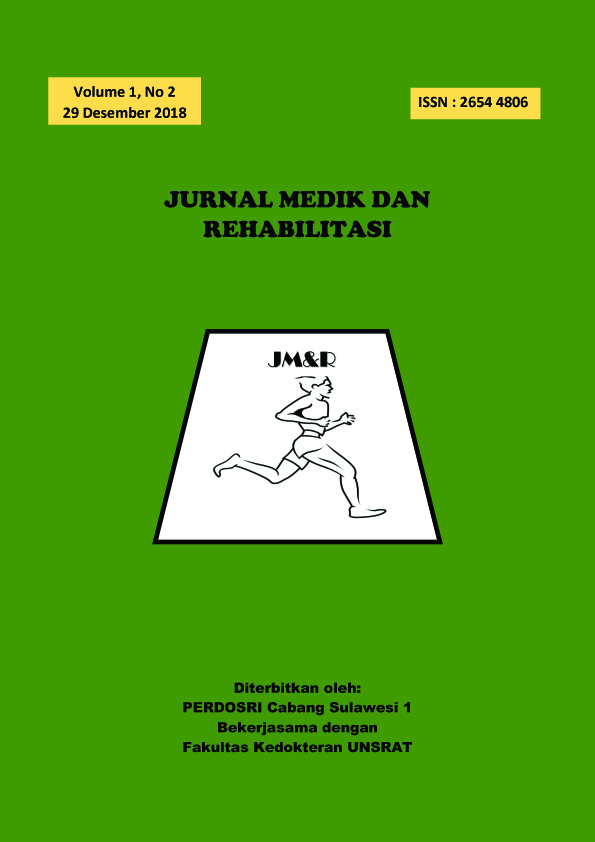RUANG RAWAT INTENSIF RSUP. PROF. DR. R. D. KANADOU MANADO PERIODE JULI 2017 - JULI 2018
Abstract
Abstract : Patients in ICU are mostly immunocompromized and are monitored invasively so they are very susceptible to infection. Infections that occur in healthcare services are called nosocomial infections. Nosocomial infection is an infections that acquired in hospital or healthcare service units that first appear 48 hours or more after hospital admission or within30 days after patient is discharge from patient care. The incidence of nososcomial insfections in ICU is higher than in other inpatient units, which is around 75%. Several studies on microbial patterns in hospital that have been reported indicate changes in microbe pattern. Aims : To determinate the description of microbial patterns and antibiotic sensitivity in ICU patients at R. D. Kandou General Hospital Education, Manado for the period of July 2017 – July 2018. Methods : This study was conducted in a retrospective descriptive design. Data is collected from secondary data of patient’s medical record. Results : Based on the research, there were 16 types of microbes. Most of the microbes are Acinetobacter baumanii  (26%), followed by Klebsiella pneumoniae (20%) Eschericia coli (12%), Streptococcus viridans (8%), Staphylococcus aureus (6%). Data from antbiotic sensitivity test results did not provide significant results.Conclusion : The most commonly found microbes which derived from gram negative bacteria was Acinetobacter baumanii with antibiotic sensitivity test data did not provide significant results.Key words : antibiotic sensitivity, ICU, microbial pattern, , nosocomial infections.
References
World Health Organization. Comprehensive safe hospital framework. WHO international: World Health Organization; 2015
Intensive Care Unit. Rockingham. http://www.rkpg.health.wa.gov.au/Our-services/Service-Directory/Intensive-Care-Unit (accessed September 25, 2018).
Intensive care. NHS Choices. https://www.nhs.uk/conditions/intensive-care/ (accessed September 25, 2018).
Nazir A, Kadri S. An overview of hospital acquired infections and the role of the microbiology laboratory. International Journal of Research in Medical Sciences 2014;2:21–7. doi:10.5455/2320-6012.ijrms20140205
Mukhopadhyay C.Infection control in intensive care units. Indian journal of respiratory care.2018;07;14-21 [cited at August 18th 2018]
Kuswiyanto. Bakteriologi 1 Buku Ajar Analis Kesehatan. 2016. Jakarta: Penerbit buku kedokteran : EGC;2006. P 85-95
Taslim, E. Pola kuman terbanyak sebagai Agen Penyebab Infeksi di Intensive Care Unit pada Beberapa Rumah Sakit di Indonesia. Departemen Anestesi dan Terapi Intensif Fakultas Kedokteran Universitas Padjajaran. 2016 Feb;32(1):56-62
Gobel, S. Pola bakteri aerob yang berpotensi menyebabkan infeksi nosokomial di Instalasi Gawat Darurat RSAD Robert Wolter Mongonsidi Manado. Jurnal e-Biomedik. 2016 Juli-Des;4(2):1-7
Londok, P. Pola bakteri aerob yang berpotensi menyebabkan infeksi nosokomial di ruang ICU BLU RSUP Prof. Dr. R. D. Kandou Manado. Jurnal e-Biomedik.2015 Jan-Apr;3(1):448-52
Kariadi DRD. Panduan kriteria pasien masuk dan keluar ruang rawat intensif. RSUP Dr. Kariadi Semarang. 2013:8-9
Yepez ES, Bovera M, Rosenthal VD, Flores HAG, Pazmino L, Valencia F, et al. Device-associated infection rates, mortality, length of stay, and bacterial resistance in intensive care units in ecuador: international nosocomial infection control consortius’s findings. World journal of biological chemistry.2017;8(1):95-101. doi.org/10.4331%2Fwjbc.v8.i1.95
Iregbu K, Sonibare S. Profile of Infections in Intensive Care Unit (Icu) in a Central Nigeria Tertiary Hospital. African Journal of Clinical and Experimental Microbiology.2014;16:23. doi:10.4314/ajcem.v16i1.4
Bhandari P, Thapa G, Pokhrel BM, Bhatta DR, Devkota U. Nosocomial Isolates and Their Drug Resistant Pattern in ICU Patients at National Institute of Neurological and Allied Sciences, Nepal. International Journal of Microbiolog. 2015;2015:1–6. doi:10.1155/2015/572163.
Dasgupta S, Das S, Hazra A, Chawan N. Nosocomial infections in the intensive care unit: Incidence, risk factors, outcome and associated pathogens in a public tertiary teaching hospital of Eastern India. Indian Journal of Critical Care Medicine 2015;19:14. doi:10.4103/0972-5229.148633.
Wong D, Nielsen TB, Bonomo RA, Pantapalangkoor P, Luna B, Spellberg B. Clinical and Pathophysiological Overview of Acinetobacter Infections: a Century of Challenges. Clinical Microbiology Reviews.2016;30. doi:10.1128/cmr.00058-16.
Iliyasu G, Daiyab FM, Tiamiyu AB, Abubakar S, Habib ZG, Sarki AM, et al. Nosocomial infections and resistance pattern of common bacterial isolates in an intensive care unit of a tertiary hospital in Nigeria: A 4-year review. Journal of Critical Care.2016;34:116–20. doi:10.1016/j.jcrc.2016.04.018
Hemalatha S.Extended spectrum beta lactamase (ESBL) mechanism of antibiotic resistance and epidemiology. International journal of pharmtech research.2014-2015;7(2):303-09.

